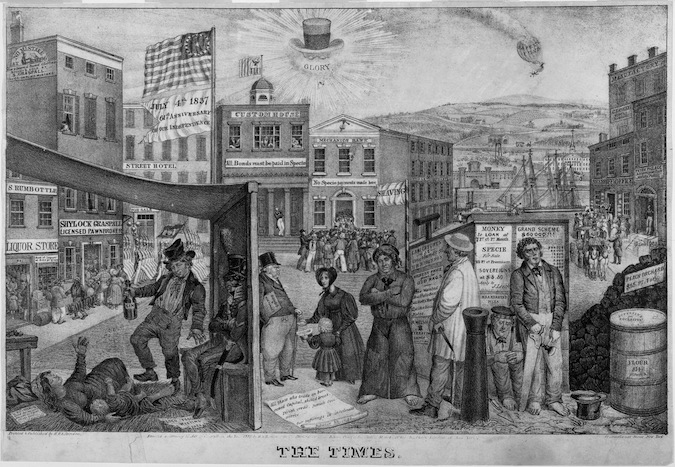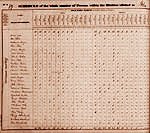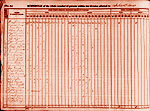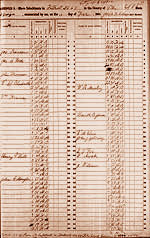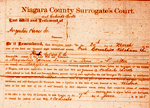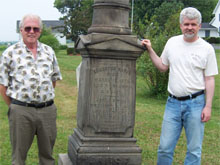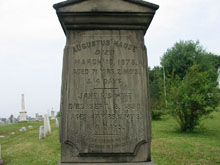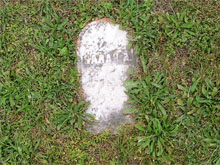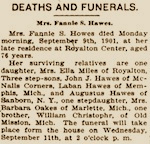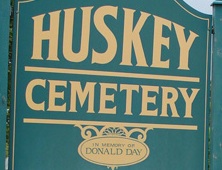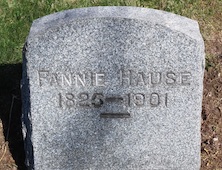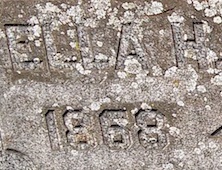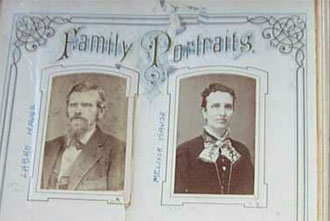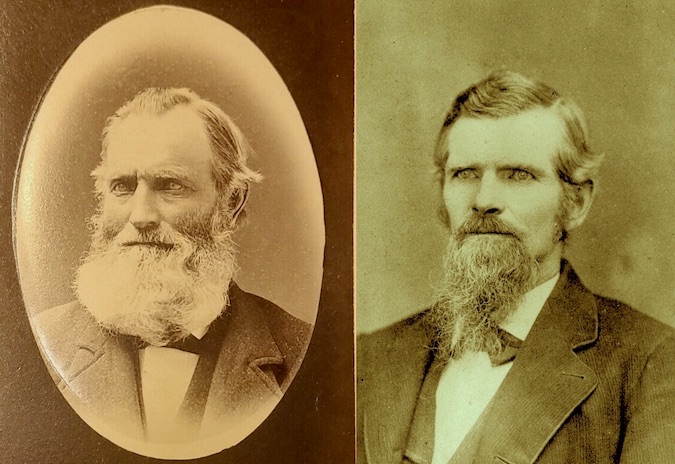 |
"To tell the truth, it has as forbidding an aspect as any spot that has yet been encountered. Ledges of rock, giant forest trees, log and brush heaps, log shanties and rattlesnakes made up a rude landscape that is vividly daguerreotyped in my memory."
—The diary of Lyman Spalding describing the construction of the Erie Canal in Niagara County.
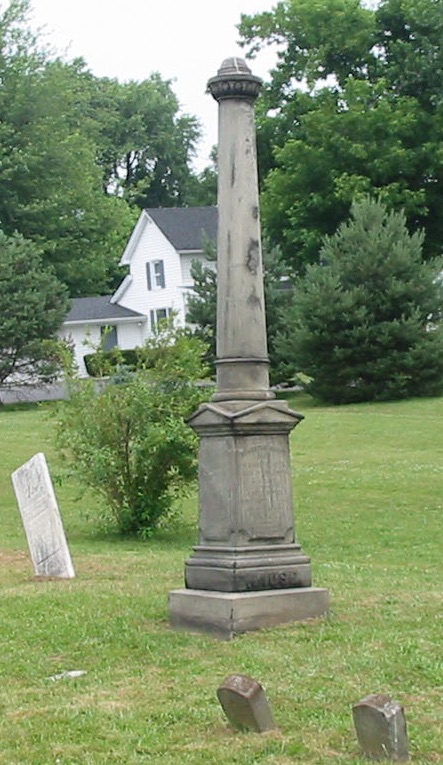 The Augustus Hause monument at the Royalton Union Cemetery was 15' feet tall, until collapsing in the 2010s. |
Like his country, Augustus would aggressively seek out new lands and opportunities throughout his life. An ambitious, independent man, he would leave the huge family homestead in Fayette to start his own farm and grow rich by shipping his goods via the Erie Canal. He would marry twice and father children well into his sixties. While he was aggressive and willing to take risks, Augustus was not reckless. He was a devout man who would become a local leader in the American Temperance movement.
Around 1806, Augustus moved with his parents to the Finger Lakes region of the state, in Fayette, Seneca County. He helped work a large farm on "Hause's Point" along Cayuga Lake. The John Hause property so well-known that it was used as a point of reference by the US Congress as they planned interstate travel routes. Augustus' early years were spent in a beautiful location with a prominent, prosperous farming family, in what seemed like an idyllic childhood.
That all changed in the War of 1812, when his father, a sergeant in the cavalry, was taken prisoner at the Battle of Lundy's Lane and held in Canada by the British army. Augustus, not even ten years old, probably wondered if he would ever see his father again, and the fear of that loss probably cemented the independent, self-reliant streak that would aid him later in life. Fortunately, John Hause returned home when the war ended, and life went back to normal. Augustus never had to face an invading army like his father or his grandfathers, and grew to adulthood during the first relatively peaceful period in the country's history (there wouldn't be another war until the United States got so tired of peace that it would declare war on itself during the 1860's, but that was still a long way off).
After his father's return, Augustus attended one of seven new schools in the town—or possibly a German school in nearby Bearytown in a log church. Bearytown also featured the infamous inn of Henry Beary, which opened in 1819. This tavern hosted political conventions and was considered the best entertainment spot in the area. Beary's was known for its roast pig, poultry and game, as well as draughts of cider royal, metheglin and peach brandy. For large political gatherings they would even barbecue an ox or two. Augustus probably went there with his father, where John and the locals traded war stories and discussed politics, or the number of wives the Mormon guy had in lot #13.
This was a time for invention and expansion in the United States, and Augustus was about to invent and expand a family. During the 1820's, he fell in love and married JANE JONES of New Jersey (4 Sep 1802 - 8 Sep 1850). Jane is another one of the mystery women in our family history. Her surname was so common, and so little was recorded of her, that we can't trace her genealogy. Anyway, she and Augustus had the following children:
CHILDREN OF AUGUSTUS HAUSE AND JANE JONES |
|
|
|
|
|
|
|
|
|
|
The Book of Mormon claims that the twenty-five hundred year-old sword was the ancestral sabre wielded by the ancient "Nephite" prophets, including Laban of Egypt, who had handed it down generationally through the centuries until it reached... Joseph Smith, Jr., who had moved to Fayette in the 1820's. Smith claimed to be a direct descendant of Laban, and that the sword had been handed down to him as his birthright. Smith had apparently kept it to himself, however, until June of 1829, when he "received a revelation from the Lord" permitting him to reveal the sword to Fayette residents Oliver Cowdery, David Whitmer, and Martin Harris. Brigham Young later declared that the group had observed the sword of Laban as it hung upon the wall, and it carried this inscription: "This sword will never be sheathed again until the kingdoms of this world become the kingdom of our God and his Christ."
This sword and its apocalyptic message obviously would have been big news in tiny Fayette—or at least a hot topic of conversation in the local taverns. Fayette was an extremely superstitious area, and any revelation like this would have been taken very seriously—either as a miracle or a threat.
Augustus remained a Baptist who eschewed Mormonism, but he did apparently like the name of "Laban" enough to bestow it on his second son in 1831. At the same time, his neighbors declared the Mormon movement to be heretical and drove its faithful out of New York—to what Joseph Smith called the promised land of Ohio (talk about your false prophecies). Augustus moved his family out of Fayette the same year, to the town of Royalton in Niagara County, New York. But he didn't go for religious reasons (as far as we know). A hardworking, ambitious Baptist like his father and grandfather, Augustus wasn't looking for any promised land—cheap farmland would be good enough, and the promise of the Erie Canal.
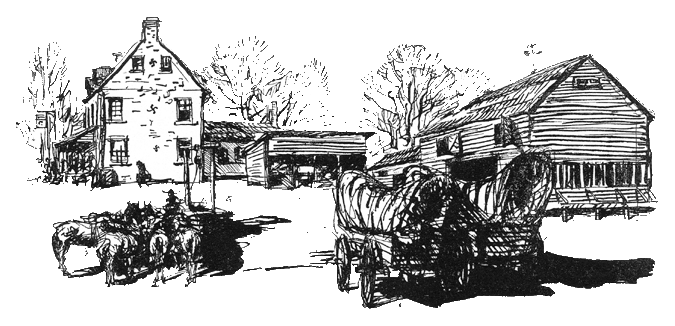
Niagara County had been a vast, untamed, unpopulated wilderness until the nineteenth century, except for some British forts and loyalist settlements along the Niagara River (and, of course, the Native Americans who lived there first). The British retained Fort Niagara even after the Revolutionary War to ensure that Tories could be properly compensated for confiscated lands. In 1791, Robert Morris bought half a million acres of land that was then Massachusetts, including Niagara County. Over the next two years, he sold it all to agents of the Holland Land Company. Then in 1797, the Indians' claim to the land was extinguished for a fee of... well, next to nothing, and they were forced to leave. In 1808 the county of Niagara was created out of Genesee County, and the Indian trails were improved to handle the ox carts. Eventually, Connestoga Wagons drawn by four to six horses could traverse the woods. The first settlers made their livings creating potash salts, made from the ashes of burned trees, or they created barrel staves for whiskey containers from smaller trees.
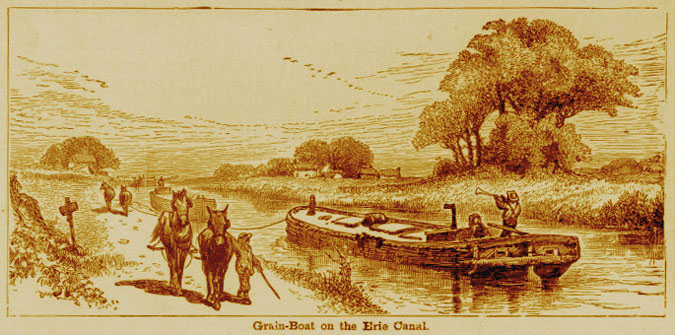 |
In 1819, land speculators learned that the proposed Erie Canal would pass through the area now known as Lockport, and began buying up the land. The first speculators were a group of men from Ontario County, New York, called The Society of Friends, more commonly known as Quakers. Others were unsure of the impact that the canal would have, and waited.
At this time, most of Niagara County was covered with virgin forests except for a narrow strip of land reserved for a state highway (now Market St. in Lockport) and two or three small clearings. But in January of 1821, advertisements appeared in New York City seeking men to work on the Erie Canal in Niagara County. The workers could expect "wages, and keep" (which meant food and whiskey), attracting a very un-Quaker-like class of people. The population now swelled to 2,000—many of whom were Irish—to work on the canal. These laborers cleared the woods and excavated rocks in preparation of building the locks.
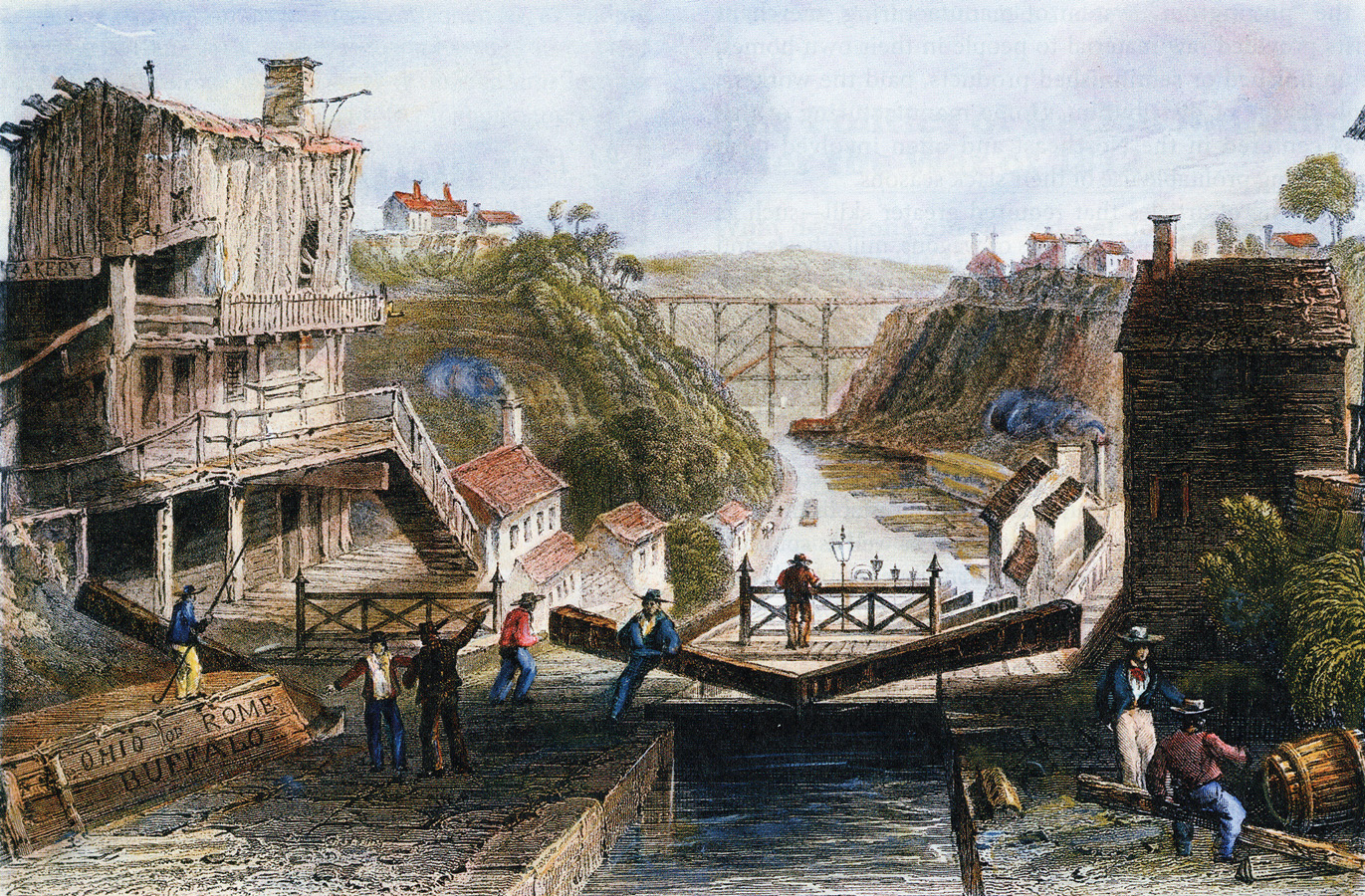 "Lockport, Erie Canal," by W.H. Bartlett. View looking east from the top eastbound lock. Engraved by W. Tombleson (London : published for the Proprietors by Geo. Virtue, 1838) (Click to enlarge.) |
The full length of the Erie Canal opened on 26 Oct 1825, as Governor DeWitt Clinton came through Lockport aboard the Seneca Chief and passed successfully through the twin flight of locks. The first boat from the East, the Captain Swan, passed through the locks on October 29. It was the engineering marvel of its day, with 18 aqueducts to carry the canal over ravines and rivers, and 83 locks, with a rise of 568 feet from the Hudson River to Lake Erie. It was 4 feet deep and 40 feet wide, and floated boats carrying 30 tons of freight. Numerous bridges had to be built across the canal to accommodate roads and farms which were severed by the waterway. A ten foot wide towpath was built along the bank of the canal for horses, mules, and oxen led by a boy boat driver or "hoggee." Horses and mules drew barges through the canal in end-to-end fifteen-mile shifts. And the ferryman sang his familiar song: "I've got an old mule, her name is Sal, Fifteen miles on the Erie Canal. She's a good old worker and a good old pal, Fifteen miles on the Erie Canal..."
The effect of the Erie Canal on the economy and industry in the United States was staggering. Cargo that had taken two weeks to carry by road could now be moved in three and a half days. Farmers now could sell flour back east for a living, as freight rates for their products that had cost $100 a ton by land could now be be shipped by Canal for eight to ten dollars per ton.
The canal came at an extremely prosperous time in the US economy, and it initially caused land prices to soar in New York, and many farmers were more interested in the quick profits from land speculation, as people and businesses migrated into the area, than in producing crops. Real estate prices in New York rose 50 to 150 percent between 1830 and 1836, and investors borrowed enormous amounts to buy the land (bank loans across the country doubled from $28 million to $56 million during those same years).
In Niagara County, the economy was driven by Benjamin Rathbun of Buffalo—not just a resident of Buffalo, but a village president, hotel owner, merchant, financier, building contractor and land developer. His fortune was estimated at more than $3 million, and by 1836, Benjamin employed more than 2,000 persons—nearly one-third of Buffalo's entire work force—paying out $10,000 a day in wages, from his three banks. He also owned a score of other businesses, and had built practically all of Buffalo's buildings—using other people's money, and spending more than was coming in... but in the booming economy, with the promise of the canal, nobody noticed.
A small farmer in Seneca County like Augustus Hause must have watched all of this land speculation, spurred by the revolution in agriculture, with envy and amazement. He and his father were doing okay—their goods could reach the Erie Canal from Waterloo and Seneca Falls, by way of the Seneca River—but the Seneca Lock Navigation Co., a private enterprise formed in 1813, had dammed three sets of rapids and installed locks, so farmers had to pay them to get their goods transported to the Canal. Augustus was stuck working on his small parcel of Hause point land, away from the canal... until something wonderfully horrible occured, and the booming economy came crashing down...
THE AGRICULTURAL REVOLUTION IN NIAGARA COUNTY, 1800-1837 |
The "Panic of 1837" was a financial crisis in the United States that touched off a major recession, lasting until the mid-1840s. Speculative lending practices and a collapsing real estate bubble, among other factors, caused a crisis in banking. Confidence in the financial system got so bad that the Secretary of the Treasury finally announced that payment for government lands had to be made in gold and silver after August 15, 1836, and that paper money wouldn't be accepted. The reaction to the announcement was disastrous. On May 10, 1837, banks in New York City suspended exchanging their coin for customers' bills, meaning that they would no longer redeem paper money at full face value. Within two months, the losses from bank failures in New York City alone aggregated nearly $100 million. Business closures, unemployment (25% in some areas) and bankruptcy ran rampant. In Niagara County, many lost their savings to Benjamin Rathbun, who was convicted of forging loans to finance his schemes, his multi-million-dollar empire collapsing in ruins.³ The people he swindled, financed or employed were forced to declare bankruptcy or sell prime land near the Erie Canal. It was a perfect moment for a hardworking yeoman like Augustus Hause to take the next step, and buy a farm of his own with the small amount of money he had saved.
On 20 Jun 1837, a month after the start of the crisis, Augustus took advantage of the burst real estate bubble to purchase 100 acres of prime farming property in Royalton from Benjamin Knower (Royalton Deeds, Book 19, page 356, Lot #59) for $450. Then a year later, on October 15th, Augustus "Hawes" bought just over 56 acres in an adjoining lot from Charles E. Dudley of Albany (Royalton Deeds, Book 22, page 153, lot #57) for $270. Buying these prime properties near the canal at the lowest ebb of the recession, the value of the farmland had nowhere to go but up.
|
||||||||||||||||||||||||||||||||||||||||||||||||||||||||||||||||||
Augustus may not have been able to spell his name consistently, if at all, but he was still a shrewd investor. These purchases gave him almost 160 acres of fertile soil for $720, so while the prices of agricultural commodities dropped sharply in the recession, driving many farmers off their land and into factory jobs in Albany, Rochester, Syracuse or Buffalo, Augustus had a lower overhead and could actually expand. Augustus gambled that the Erie Canal, which ran right through town, would make this property much more valuable in time, as the recession faded—and he was right by more than tenfold.
The canal eventually changed the economy of the country, and of northern New York especially. Freight from New York to Ohio traveled a third faster than by wagon, and at half the cost. New York was a more profitable market for farm products than New Orleans, so traffic on the Mississippi evaporated while New York boomed. In fact, the canal was so cost effective that a customer in Savannah, Georgia, could buy Augustus' wheat in New York cheaper than wheat grown in the central part of his own state! Furthermore, improvements in farm equipment, like horse-drawn reapers and threshing machines, made farming much easier and more lucrative. Augustus could use much more of his acreage than his father could, even with a hundred fewer acres of property.
Unlike the hilly "Finger Lakes" region of New York that Augustus was raised in, which was known more for wines than wheat, Niagara County was flatter and greener, and ideal for raising animals and grains like wheat and barley, and the orchards supplied the country with apples and peaches. With the Erie Canal opening new markets for his crops, Augustus had found an ideal place to prosper.
THE AGRICULTURAL REVOLUTION IN NEW YORK, 1840-70 |
| 1840 | 1840-1850 - New York, Pennsylvania, and Ohio are the chief wheat States. Agriculture booms in NY, thanks to the Erie Canal, and Rochester is nicknamed the "Flour City." 1840 - New York population nears 2 million. 1840 - Almost 3,000 miles of railroad tracks in the United States. 1842 - First grain elevator is invented in Buffalo, New York. 1842 - The congregation of the Hause family's Baptist church suffers a drastic split when some members leave to follow the end-of-the-world teachings of William Miller, the originator of Millerism, who spoke in Lockport. He and his devotees are certain that the world will end on April 21, 1843. 1843 - On April 21, the day passes without incident: No end of days, no returning Jesus, no hellfire, damn it. The Millerists announce there has been a calendar mix-up, and predict a new date for the end of the world: April 18, 1844, based on the Karaite Jewish calendar (as opposed to the Rabbinic calendar). 1843 - Sir John Lawes founds the commercial fertilizer industry by developing a process for making superphosphate. 1844 - April 18 passes without incident: No end of days. Millerites announce that they had entered the "tarrying time"—a time of waiting after which Christ would finally return—spoken of in Matthew 25:5 and Habakkuk 3:2-3. This belief sustains the Millerites through the months of May to July, 1844. Finally, a new date is announced: "the tenth day of the seventh month of the present year, 1844." Again using the calendar of the Karaite Jews, this date is determined to be October 22, 1844. 1844 - October 22 passes without incident: No end of days. Millerite leaders and followers are disillusioned. Some Millerites predict different dates—among them April, July, and October 1845. The majority however, give up their beliefs and attempt to rebuild their lives... and buy new calendars. 1844 - Practical mowing machine is patented. 1844 - Success of the telegraph revolutionizes communications. 1845 - A bathing establishment advertises in the Niagara Democrat that Shower Baths are ready to use at the Big Mill in Lockport. Terms of $1 per person conferred the right to shower once a day or "oftener" throughout the year. The advertiser noted, "it is unnecessary to remark upon the comfort of daily ablutions, at least during warm weather, to say nothing of the conduciveness to health. Those wishing the luxury of being clean, can have the privilege of washing as often as they please." 1845 - The Goshen Democrat publishes a death notice for Johnny Appleseed in its 27 Mar 1845 paper, citing the day of death as March 18 of that year, at the age of 80. "Many of our citizens will remember this eccentric individual, as he sauntered through town eating his dry rust and cold meat, end freely conversing on the mysteries of his religious faith. He was a devoted follower of Emanuel Swedenborg, and notwithstanding his apparent poverty, was reputed to be in good circumstances." 1846 - First use of adhesive postage stamps on letters. Lockport postmaster Hezekiah Scovell is the first postmaster in Western New York to use adhesive on postage stamps, an item which he designed especially for Lockport. It is unpopular, because the sender has to purchase the stamp (up to that point, the cost to mail a letter was usually paid by the recipient, not the sender). In fact, the Lockport Daily Journal & Courier of March 15, 1862, asks Augustus Hause to come down to the post office and pay for a letter. 1847 - A second set of locks is completed on the Erie Canal in Lockport. They now allow for twice as much boat traffic. 1848 - On the night of March 29, an ice jam forms on Lake Erie near Buffalo, blocking the water that flows along the Niagara River and over Niagara Falls, marking the first and only time that both the American and Canadian sides of the Falls fall silent together. Some feel it is an evil omen, and churches hold special services to help allay the fears. Millerites are disappointed once again when the ice thaws and the world survives. 1849 - Mixed chemical fertilizers sold commercially |
| 1850 |
1850's - Commercial corn and wheat belts begin to develop; wheat occupies the newer and cheaper land west of the corn areas. 1850 - New York population: 3,097,394, growing over one million in ten years. 1850 - About 75-90 labor-hours required to produce 100 bushels of corn (2-1/2 acres) with walking plow, harrow, and hand planting. 1850 - Passengers can travel over 9,000 miles across the U.S. on steam-engine trains. 1850-70 - Expanded market demand for agricultural products bring adoption of improved technology and resulting increases in farm production. 1850 - The first commercial orchard of peaches in the county is planted by John Burdette. The success of the Erie Canal after 1825 enabled area farmers to take advantage of eastern markets for apples, but peaches were too perishable to withstand the slow canal transportation process. With the advent of the speedier New York Central Railroad in 1852-3, travel time was greatly reduced and peach growers now had a chance to ship their fruit to New York City and beyond. As a result, Niagara County farmers began to plant peach orchards in the shade of the Niagara Escarpment as it stretched out to Lake Ontario. 1854 - Self-governing windmill perfected 1855 - Melvin Shaver, a native of Somerset who married into the House family, wrote of his recollections of apple harvest time. He noted that the process was made much more difficult by the height of the apple trees. Standard tree height exceeded thirty feet and those picking the crop usually worked from 35-foot ladders in order to reach some of the fruit. Pickers worked 12 hours per day and six days per week, for which the average wage was $1.25 per day. Shaver remarked that in the 1850s, there were no aphis or other insects in Niagara County. Spraying at that time was unknown. Aphis entered the region at a later date, arriving from Asia. An orchard in Lewiston was first affected and soon all of the trees in the area died and later, it became necessary to spray all of the trees in the county. 1855 - Augustus' children Laban, John and Basheba head up the Erie Canal with their families and members of the Dysinger clan, settling in Michigan. 1856 - 2-horse straddle-row cultivator patented. 1858 - Mason jars, used for home canning, are invented. |
| 1860 | 1860 - Wisconsin and Illinois are now the chief wheat States. 1860's - Kerosene lamps become popular. 1861 - In February, Lincoln's train passes through Niagara Falls and Lockport on its way to his inauguration in Washington. 1861 - News of the surrender of Fort Sumter and the start of the Civil War reaches Niagara County by wire early in the morning of April 14. The printers of the Journal and Courier labor at the presses through the night and send the newsboys scrambling into the streets. The banner headline reads, "War! War!" 1861 - The departure of the 28th for Albany on May 17 is the occasion of a great celebration. Escorted by the 66th Militia, the Continental Home Guards, the Lockport Fire companies and the Niagara Baseball Club, they parade to the New York Central Depot, stopping for a farewell address in front of the American Hotel. 1861 - Mary Todd Lincoln returns to the area in September for a shopping spree. She spends time in Niagara Falls and Lockport. A few weeks later, a mysterious package with an odd odor, addressed to Mrs. Lincoln, arrives at the White House. The President, fearing that perhaps a mouse has gotten into the package and died, decides to open it himself to spare his wife the displeasure of its contents. It turns out to be patterns from a Lockport dress shop, without any mouse inside. 1861 - Augustus Hause, Jr., enlists on October 15 in Royalton, at the age of 23. He serves in Company E of the 8th New York Cavalry (Unit 1326), also called the Rochester Regiment, and the Crooks Cavalry Regiment. 1861 - William H. Bush, owner of the Oyster Saloon located under the Exchange Bank in Lockport, learns of President Lincoln's call for 75,000 army volunteers before official notice was given, in anticipation of the Civil War. He posts signs on the Pine Street wall of the saloon, asking for recruits to sign up offering to lead them as their captain. They become the first volunteer regiment of the Civil War. 1863 - The ranks of the 28th are so decimated, that they were ordered home to be mustered out of service. On their arrival in Lockport on May 20, they received a royal reception and paraded to the fair ground. Nearly 4,600 men from the county fought in the war and of these, more than 800 were killed or died of illnesses or in prison camps. Many others came home to Niagara County with their health shattered and lived only a few more years. 1864 - Augustus Hause, Jr., is discharged on 08 December in Rochester, New York, as a Corporal with a Distinguished Service medal. 1865 - In April, Lincoln's funeral train passes through Lockport and Niagara Falls on its way to Illinois. 1865-75 - Gang plows and sulky plows came into use. 1868 - Steam tractors were tried out 1868 - Augustus Hause sells his last hundred acres and retires from farming, moving into Lockport. 1868 - Mary Ellen Powers is born on June 6, nearly 2 feet tall at birth, and grows up on Grand Street in Lockport. Mary Ellen grew to be known as "The World's Tallest Lady," and traveled with the Barnum & Bailey Circus and other purveyors of oddities. She stopped growing at age nineteen, topping out at seven feet tall. (The median height at that time was barely five feet.) 1869 - Spring-tooth harrow or seedbed preparation appears. |
| 1870 |
1870 - Total US population: 38,558,371; farmers make up 53% of labor force. 1870 - Illinois, Iowa, and Ohio are the chief wheat States. 1870's - Silos came into use 1870's - Deep-well drilling first widely used 1874 - Glidden barbed wire patented 1874 - Availability of barbed wire allowed fencing of rangeland, ending era of unrestricted, open-range grazing 1877 - Belva Ann Bennett McNall Lockwood, a native of Royalton, was living in Washington, D.C. pursuing a career in law and making a name for herself in the women's suffrage movement when Moses Richardson, the editor, printer and pressman of the Lockport Daily Journal, wrote a love letter to the lady lawyer in Washington, but changed his mind about sending it. It apparently got mixed up with some other papers and Richardson later used the reverse side to write an editorial and sent it off to be printed. Somehow the typesetter printed the love letter instead of the editorial. Before Richardson could correct the error, several copies had already been distributed. He soon became the butt of many a joke throughout the city. Until his death in 1890, Richardson never lived down the letter. Belva became the first woman to run for U.S. president in 1884, on the Equal Rights Party ticket, and actually received votes. She ran again four years later, helping the disenfranchised of the nation (except for Richardson). |
"Alongside the [rail]roads, whose iron bands unite our most distant cities, upon banks of rivers and canals, whose waters bear away the products of our soil, there have been springing up, intelligent thinking farmers."
—Early issue of "The Cultivator" December, 1851, VIII, 12, 385
Augustus knew that his children would need to be literate and have access to new technologies and information in order to survive and prosper in the new farm economy. Therefore, he made sure that his children would be educated. About the same time he arrived in Royalton, an academy was established at Reynale's Basin, and a building erected with funds raised by subscription, and an attendance of about ninety pupils was secured. The institution continued about ten years, when it was given up and the building demolished. It wasn't a long time, but enough to make sure that Laban and the other children could write and learn the skills that they would need in the rapidly industrializing area.
|
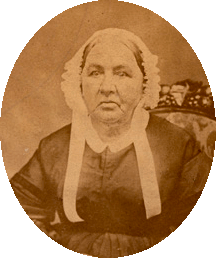
|
Augustus may have been closer to George Dysinger because of the Fayette connection, but his sons were more involved with David's family—specifically, his daughters. On September 20, 1854, Laban Hause married SARAH DYSINGER (24 Oct. 1832 - 16 March 1859), in the town of Lockport. Laban's brother, John, married a Dysinger, as well—Catherine Eve (named after her grandmother in Fayette) in the same year.
After the death of John Hause, Augustus received a parcel of Hause's Point land, along with the other remaining children. He sold the Hause Point property he inherited from John in August of 1847 to brother-in-law Gideon Wilbur. (Apparently he stayed away from Esther in Fayette, because Augustus' son, Laban, told a family historian in 1901: "In regard to the early history of them (our ancestors), I can't inform you as I was never with my grandparents to learn of them.")
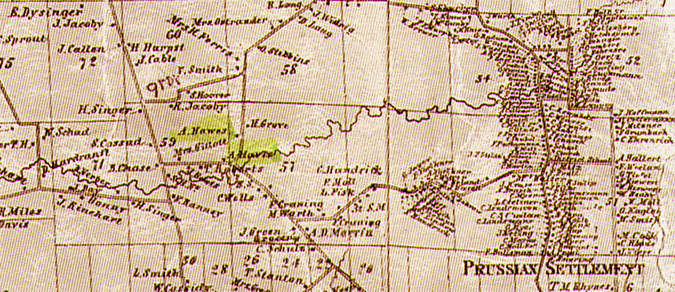 A map of Royalton with Augustus' land, marked "A. Hawes," highlighted. (Click to enlarge.) |
| ||||||||||||||||||||||||||||||||||||||||||||||||
In the Hause family, Esther Hause was now staying with her son Alanson back in Fayette. Augustus "Hawyes," one of the worst "Hause" spellings yet, is listed as a farmer, and the value of his land is priced at $4240. His wife, Jane, is recorded as 47 years old, but she would die within months. Their son, 19-year-old Laban (spelled "Laben Haws" by the enumerator), is listed on the next page:
|
The Hause family attended the First Baptist Church of Christ in Royalton, organized in 1822 "at the schoolhouse that stood near the graveyard in the neighborhood that is now called Locust Tree." The first church was built in 1823, then moved a half-mile east to a new building in 1869, and the name was changed to the Royalton Community Church. (Locust Tree is now known as Dysinger's Corners, as that family opened a hotel and post office there.) A cemetery stood next to the original church/schoolhouse. It was called the Royalton Union Cemetery (also called the Dysinger Cemetery because it situated was across from their estate, and they had all of their family members buried there) and was incorporated in 1848, although some burials were made earlier.⁴
Sadly, there was about to be a new resident to the graveyard...
Jane Hause died on September 8, 1850. Like everything else concerning Jane, there were few details handed down about the death. She was buried down the road from the farm at the church cemetery.
But at the age of 46, Augustus was still trying to enlarge his family. Within two years he fell on love again, with a much younger woman, and decided to remarry. According to the Niagara Democrat newspaper, on December 19, 1852, Augustus wed a woman named FANNIE S. CHRISTOPHER (b. 18 Oct 1825), who also lived in Royalton.⁵ She was just 26 years old, having lived 25 of those years in Niagara County (she was born in Monroe).
In the New York state census of 1855, Augustus Hause and Fannie lived in a $1200 plank farmhouse with children Basheba, 19, and Augustus Jr., 17. (His first son, John, lived nearby with his wife Eve Dysinger-Hause, while John's brother Laban Hause had moved to Michigan with Eve's sister, Sarah Dysinger-Hause). How the rest of Augustus' family felt about Fannie—over 21 years younger than him, and just four years older than his first child—was never recorded.

Then Augustus and Fannie moved into town, settling on an eleven acre property with a frame house, worth $700, according to the 1865 state census. Augustus became a Life Member of "The State League," an organization operating to stop liquor traffic ("rum rule") in New York.
"This organization is designed to operate against the liquor traffic, employing all available means to counteract, oppose, and suppress this enemy to our civil and religious institutions. It is designed to combine individual influence with individual effort, and a concentration of many individuals through the merits of our efficient organization. It is designed to indicate those who are in favor of its object, and opposed to rum rule."
—"The State League" newspaper, 1 Jun 1867.
| |||||||||||||||||||||||||||||||||||
Ever the good Baptist, Augustus joined the State League, an association that worked to discourage the sale of liquor in New York, and even ran its own newspaper out of Syracuse, from 1858-1869. Augustus was in every issue as the the representative for Wolcottsville, a hamlet in Royalton, located today on the western side of the Tonawanda Wildlife Management Area (he's under "Niagara County" on the page, at left). The movement stalled however, to the point that a "Whiskey Ring" scandal in the federal government was exposed in 1875, in which a group of mostly Republican politicians, including President Grant's personal secretary, were able to siphon off millions of dollars in federal taxes on liquor, proving that the only thing more corruptive than liquor was politics.
But while Augustus was through with the evils of alcohol—and even through with farming—he wasn't through having kids. Apparently the influx of money from his farm sale, mixed with the allure of a young wife, had Augustus procreating like a drunken sailor. He had two more daughters with Fannie—the last when Augustus was 63 years old (which, of course, makes him the all-time Hause family iron-man). You can imagine the reaction when Augustus told his 43-year-old son John that he was going to have a baby sister!
Augustus and Fannie had the following children:
CHILDREN OF AUGUSTUS HAUSE AND FANNIE CHRISTOPHER | |
| |
|
| ||||||||||||||||||||||||||||||||
|
| ||||||||||||||||||||||||||||||||||||
Fannie died Monday morning, September 9th, 1901, at her residence at Royalton Center,⁷ and willed her estate of $300 personal and $1500 real property to Ella.⁸ She is buried at the Huskey Cemetery in Niagara County, located on the north side of Chestnut Ridge Road at the Lockport/Royalton Town Line.
 | |||
|
When Augustus passed away, he had lived in New York his entire life like his father and grandfather, where he prospered...
...But some of his children, seeking new opportunities, had already moved west to a new state, with open country with plenty of unclaimed land...

Laban Augustus Hause begat Frank Jr., who begat Carlisle, who begat Carleton Sr., who begat Carleton Jr., who begat Jeffrey Carleton, who begat this web page...
NOTES ON THIS PAGE:
¹—Genealogist Susan Patt, a descendant of Hannah Grove's older sister, Elizabeth, reports: "My dad's aunt always said, 'Aunt Hanna and Uncle Gus Hause in Scotts, Michigan ... He died in his rocking chair.' She would have only been a teenager at the time of his death so we don't know if she was mistaken about them being in Michigan. Perhaps she even remembered them visiting and got it confused. Hannah was an informant and listed as the nearest relative (or friend) of her brother, Samuel Grove, in the cemetery records, when he was buried in Coldwater, MI in 1903... We know they are buried in the Ward Cemetery in Wheatfield Twp, Niagara Co New York (from transcribed cemetery records) but we don't have month/date of their deaths. We have that Hannah died in 1912 and Augustus in 1913." Interestingly, the story that Augustus Jr. "died in his rocking chair" may explain one of our great family legends. For several generations, Hause children have not been allowed to rock back in their chairs because, they were told, one of their Hause ancestors died when he leaned back in his chair and the chair broke! That's the story we were told growing up, anyway...
²—The original Bathsheba was the wife King David, and is most known for the bible story in which David, while walking on the roof of his palace, saw a naked Bathsheba, who was then the wife of Uriah, bathing. He immediately desired her and later made her pregnant, then had Uriah killed... So apparently the context of a Biblical reference was not so important to Augustus when naming children.
³—Benjamin Rathbun's buildings were considered "empirical accomplishments," and no one could compete with his talents. In 1835, he had built just shy of 100 stores and dwellings in Buffalo, alone. To support his building projects, Rathbun operated stone quarries, brick plants, and machine shops. He had grocery stores and dry-goods establishments. He ran stagecoaches and horse-drawn omnibuses. He had his own private bank that issued bank notes, over his signature. He had 2,500 employees at his various businesses in which depended on him to feed their families. But Rathbun, caught up in the speculative excess that were rampant in the growing city, was spending his money quicker than it was coming in. He borrowed beyond his means, but to make matters worse, he borrowed on notes to which were forged—more than a million and half dollars in notes. Rathbun was incarcerated in the very jail he had built for Buffalo. Found guilty at a trial in Batavia, he was sent to Auburn Prison for five years. His shattering collapse in 1836 ended those paychecks and gave Buffalo a head start on the financial panic that swept the country in 1837. When he had served his time, Rathbun went into the hotel business in New York. Buffalonians still thought so highly of him that, to many of them, to stay at any hotel in New York other than Rathbun's was unthinkable.
⁴—The Dysinger-Royalton Union Baptist Cemetery is located on the north side of Bunker Hill Road between Gasport Road and Ward Road. Map. GAR recording by Ann Wallace. 1889 map in Map Book 12, pg. 1128. Incorporated in 1848 as the Royalton Union Cemetery Association. Papers in File Room under Miscellaneous Records in Register 3, pg. 193. Original papers are missing. See File #5069. Incorporated in 1957 as the Royalton Union Cemetery Association Inc. Papers in File Room in Register 4, pg. 326, File 5069. 2018 UPDATE: The cemetery is now operated by the city of Royalton. All inquiries are now to be made to the town clerk, Marie Little (trclerk1@rochester.rr.com, phone 716-772-2431).
⁵—Niagara Democrat, January 6, 1853, announcing the marriage of "Augustus House to Fanny Christopher."
⁶—Lockport Union, Sun & Journal, Lockport, N.Y., Monday Evening, April 19, 1926: "Royalton Center, Apr. 19—The funeral of Mrs. Ella Wiles, wife of Arthur Wiles, aged 58 years, who died at the City Hospital on Monday afternoon, April 12, was held on Thursday at 2 o'clock at the late residence and 3:30 o'clock at the Royalton M.E. Church, of which she had been a member for many years and was largely attended. The funeral services were in charge of Rev. J. A. Peacock of Holland, a former pastor, and Rev. H. G. Stacey. Miss Florence Woodworth and Rev. Stacey each sang a vocal solo. The floral tributes were many and beautiful. Internment took place in Chestnut Ridge cemetery in the family lot." The death date was never filled in on George Arthur Wiles's burial plot, so it's unsure if he's buried there and never negotiated to have a date carved in, or if he's just buried somewhere else.
⁷—Lockport Daily Journal, Lockport, N.Y., Tuesday Evening, September 10, 1901: "Mrs. Fannie S. Howes (SIC) died Monday morning, September 9th, 1901, at her late residence at Royalton Center, aged 76 years. Her surviving relatives are one daughter, Mrs. Ella Miles (SIC) of Royalton, Three step-sons, John J Hawes of McNalls Corners, Laban Hawes of Memphis, Mich., and Augustus Hawes of Sanborn, N.Y., one stepdaughter, Mrs. Barbara Oakes of Marlette, Mich., one brother, William Christophr (SIC), of Old Mission, Mich. The funeral will take place form (SIC) the house on Wednesday, September 11th, at 2 o'clock p.m." It's amazing how people can spell our name differently from sentence to sentence in a newspaper!
⁸—Lockport Daily Journal, Lockport, N.Y., Saturday Evening, October 5, 1901: "Light Business Today in the Surrogate's Court in this City. The will of the late Fannie Hause, of Royalton, was filed and probated today. The estate, consisting of $300 personal and $1500 real property, is left to the daughter, Ella Wiles, of Royalton, who is made executrix. Letters testamentay were issued to the latter."
TOP PHOTO: Early painting of the Erie Canal.
|
LITERARY SOURCES FOR THIS PAGE:
|
CHAPTER 1: THE LEGEND OF JOHN (JOHANNES) HAUSE (1690-?) CHAPTER 2: JOHN HAUSE OF WARWICK (1719-1794) CHAPTER 3: WILLIAM E. HAUSE (1750-1818) CHAPTER 4: JOHN HAUSE (1773-1844) AND WESTERN NEW YORK CHAPTER 5: AUGUSTUS HAUSE (1804-1875) AND THE ERIE CANAL CHAPTER 6: LABAN AUGUSTUS HAUSE (1831-1906) CHAPTER 7: FRANK AUGUSTUS HAUSE (1867-1951) CHAPTER 8: TWENTIETH CENTURY MICHIGAN CHAPTER 9: CARLISLE HAUSE (1891-1972) CHAPTER 10: THE GREAT DEPRESSION CHAPTER 11: CARLETON MARCHANT HAUSE (1917-1983) CHAPTER 12: CARLETON MARCHANT HAUSE, JR. CHAPTER 13: AFTERWARD - THE TWENTY-FIRST CENTURY APPENDIX #1: HAUSE FAMILY TIMELINE APPENDIX #2: WILLIAM HAUSE GENEALOGY APPENDIX #3: THE HAUSE FAMILY IN THE CIVIL WAR APPENDIX #4: HAUSE FAMILY BIBLES 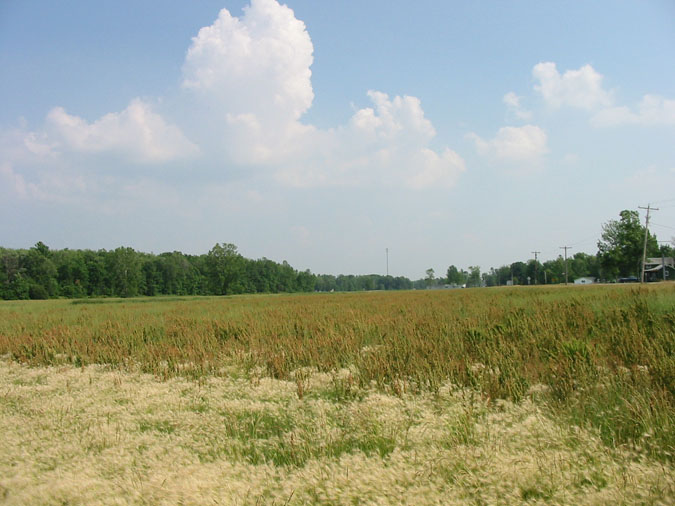 The land of Augustus Hause in Royalton, New York, as of 2006. |




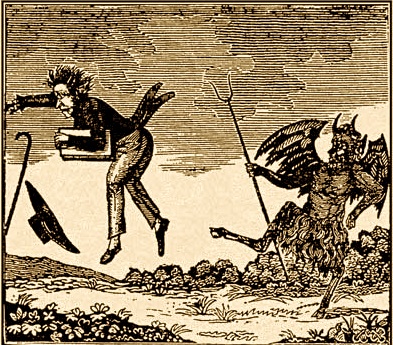
 18th century - Dutch, German, Swedish, Scotch-Irish, and English farmers settled on isolated farmsteads, and small family farms predominate; housing ranges from crude log cabins to substantial frame, brick, or stone houses; farm families manufacture many necessities; Oxen and horses for power, crude wooden plows, all sowing by hand, cultivating by hoe, hay and grain cutting with sickle, and threshing with flail.
18th century - Dutch, German, Swedish, Scotch-Irish, and English farmers settled on isolated farmsteads, and small family farms predominate; housing ranges from crude log cabins to substantial frame, brick, or stone houses; farm families manufacture many necessities; Oxen and horses for power, crude wooden plows, all sowing by hand, cultivating by hoe, hay and grain cutting with sickle, and threshing with flail.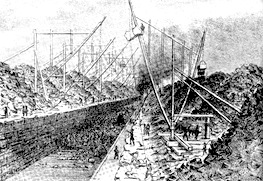 1800 - Total US population: 5,308,483; Farmers make up about 73.7% of labor force. New York population: 586,050.
1800 - Total US population: 5,308,483; Farmers make up about 73.7% of labor force. New York population: 586,050.